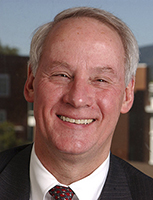(Photo above Edward Ray)
In his annual State of the University address in Portland last week, Oregon State University President Edward J. Ray challenged politicians, education and business leaders to help address the growing issue of Oregonians’ access to higher education.
He also said OSU is committed to helping the state meet Oregon Gov. John Kitzhaber’s goal of bringing economic prosperity to more Oregonians, particularly in rural communities still suffering effects of the recession.
Ray told the more than 700 people in attendance that inequality in higher education is creating a society of haves and have-nots, which “tears at the fabric of our society and undermines our democracy.” Nationally, a student from an annual household income of $90,000 or more has a one-in-two chance of graduating from college, Ray pointed out. Conversely, a student from a family with a household income of $30,000 a year has only a 1-in-17 chance to earn a college degree.
“As a first-generation college graduate myself, I know firsthand how important a college education is to one’s future as well as the collective future of our society,” Ray said. “One solution is to take a fresh look at attracting and retaining students” by having colleges and universities partner with others, including national foundations.
Late last year, Oregon State and 10 other major research universities formed the University Innovation Alliance, which seeks to raise admission numbers, retention rates and graduation rates for low-income students, students of color, and first-generation students. Some of the nation’s most prominent foundations have committed millions of dollars to match the investments made by member universities in the alliance, which will create and share new strategies to meet its goals of access and student success.
“We are doubling down,” Ray said. “I intend that Oregon State will be a showcase of access to higher education and programs that significantly improve retention and graduation rates. There is much to learn from other universities and I’m happy to say that the work is under way, as we collaborate with high school and community college partners.”
OSU is addressing the rural economy challenge in different ways, Ray said. In 2017, Oregon State will open a $60 million forest science complex in Corvallis to study and help implement the use of advanced wood products in construction of high-rise buildings in Portland – and around the world.
“This very exciting initiative will help restore high-paying jobs to rural Oregon; it will increase the value of Oregon’s natural resources across the nation; it will showcase how engineered wood products can improve the sustainability of urban cities; and it will connect the quality of Oregon wood products and pioneering know-how to fast-growing nations in Asia,” Ray said.
Also helping the state economy will be the launch of OSU’s Marine Studies Initiative, which will result in 500 students studying at OSU’s Hatfield Marine Science Center in Newport by 2025. An anonymous donor already has pledged $20 million for a new building there. Coastal communities will benefit from the research, education and outreach efforts of the initiative, Ray noted.
The OSU president called 2014 a year of “landmark achievement” for his university. Oregon State’s enrollment exceeded 30,000 students for the first time, making OSU the state’s largest university. And in December, the university concluded The Campaign for OSU, which raised $1.14 billion – the most in Oregon history.
“As an economist who likes numbers, I can tell you that the .14 figure makes me chuckle since it represents $140 million,” Ray said.
More than 106,000 donors contributed to the campaign, which achieved many highlights, including:
-Building or renovating 28 OSU buildings;
-Endowing 79 new faculty positions;
-Creating more than 600 new scholarships and fellowships serving 3,200 students.
Ray said OSU continues to lead the state in addressing research needs, garnering $285 million in total grants and contracts, including a record $37 million from industry. Over the past 18 months, the OSU Advantage Accelerator accepted and supported development of 21 business concepts into companies, and 12 grew into viable businesses, which have generated $5 million in revenues and government grants.
U.S. News and World Report ranked OSU’s online Ecampus program as the fifth best undergraduate program in the nation. At the same time, the quality of students entering OSU remains high as more Portland metro area high school valedictorians chose OSU over any other college or university. Last fall, 44 percent of the freshmen entering OSU had high school grade point averages of 3.75 or higher.
And this fall, the first freshmen class will enroll at OSU-Cascades in Bend, the state’s first branch campus.
Ray told the Portland audience that Oregon State engineering graduates have helped to build the city through working at firms including Hoffman Construction, Andersen Construction, PacificCorp, Portland General Electric and Kiewit Construction. OSU is also working to improve the metro region’s community health through the state’s first accredited public health school, as well as partnership programs in pharmacy and veterinary medicine. OSU has also established programs in the region in apparel design, business, forestry and agriculture.
“We don’t do this work alone,” Ray emphasized, “but with partners such as Intel, Nike, IBM and Boeing; with non-profit organizations and education colleagues like OHSU and Portland State.”
“The best,” Ray said, “is yet to come.”
New Analysis Puts OSU’s Economic Impact at More Than $2.37 Billion
An analysis of Oregon State University’s economic impact estimates that Oregon’s largest university contributed $2.371 billion to the global economy last year – an economic footprint that has grown by $311 million, or 15 percent, since 2011.
The greatest impact is in Oregon, where OSU was responsible for adding an estimated $2.232 billion to the state’s economy in 2014 – a figure that accounts for 31,660 jobs.
The analysis was conducted by the economic consulting firm ECONorthwest, based on OSU expenditure data, visitor data, student enrollment and a 2013 Oregon Travel Impacts study.
The ECONorthwest analysis looked for the first time at OSU’s contribution in Portland, where OSU contributed $401.9 million to the economy in 2014, along with 2,350 jobs.
The economic impact of OSU in Benton and Linn counties was $1.334 billion, along with 25,110 jobs.
Oregon State’s impacts come in three ways, direct impacts ($973 million), indirect impacts ($424.2 million) and induced impacts ($834.8 million). Direct impacts include spending on operations, goods and services, and capital construction; indirect impacts result from companies purchasing additional supplies or hiring additional employees to support spending by OSU; and induced impacts result from the purchasing power of the university’s employees.
The total does not include other significant OSU influences to the state, regional and national economies, including the contributions by university graduates or the benefits of OSU research, such as improved varieties of wheat and other crops used by Oregon farmers; spinoff companies that have major economic impacts; and scholarship that has improved public health and environmental stewardship.




1 Comment
Love the location of the west side Bend campus for OSU Cascades.
Please put a multi-story parking garage oin the original plan. It will be needed and it will quiet those complainers about parking problems.